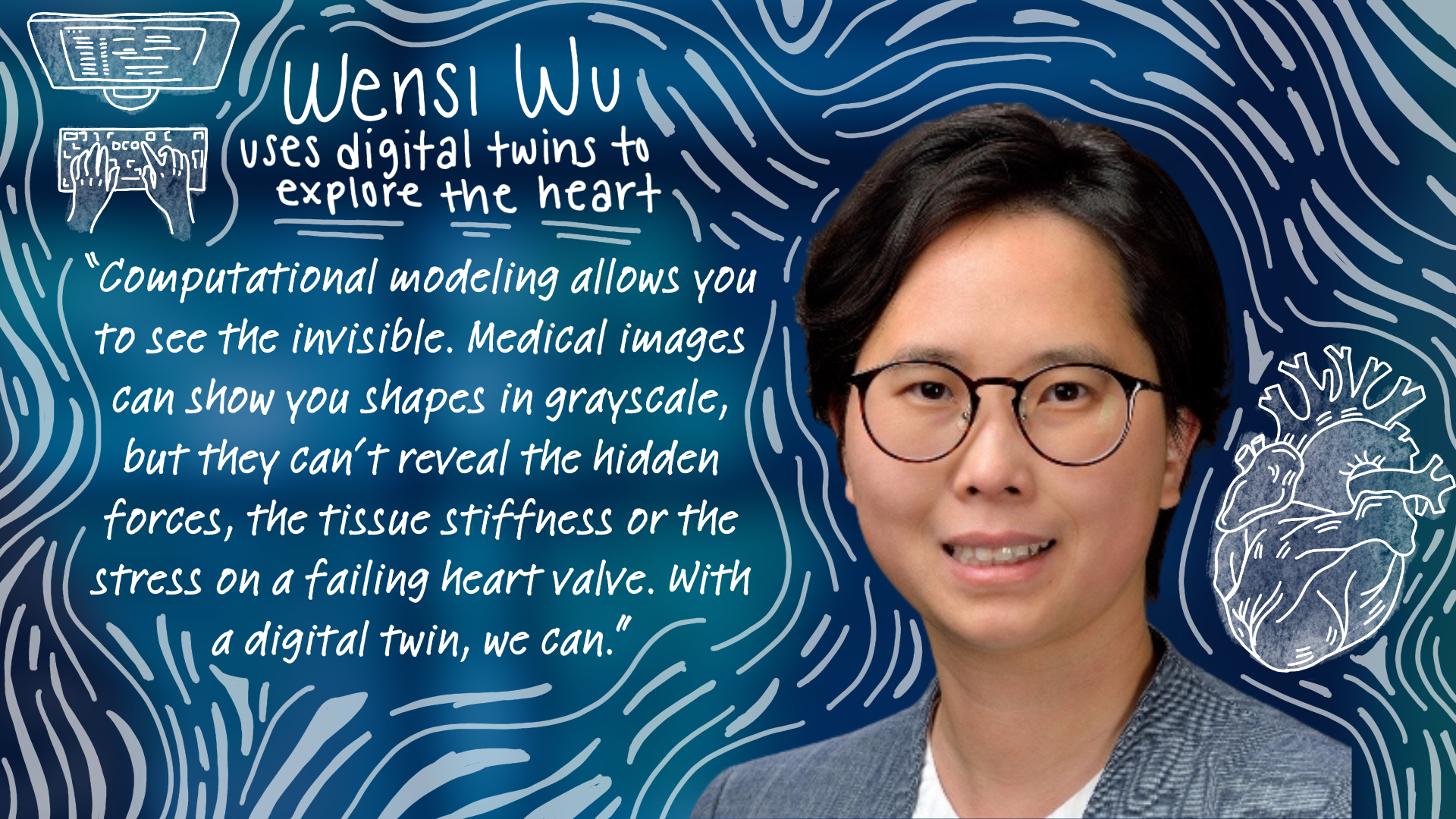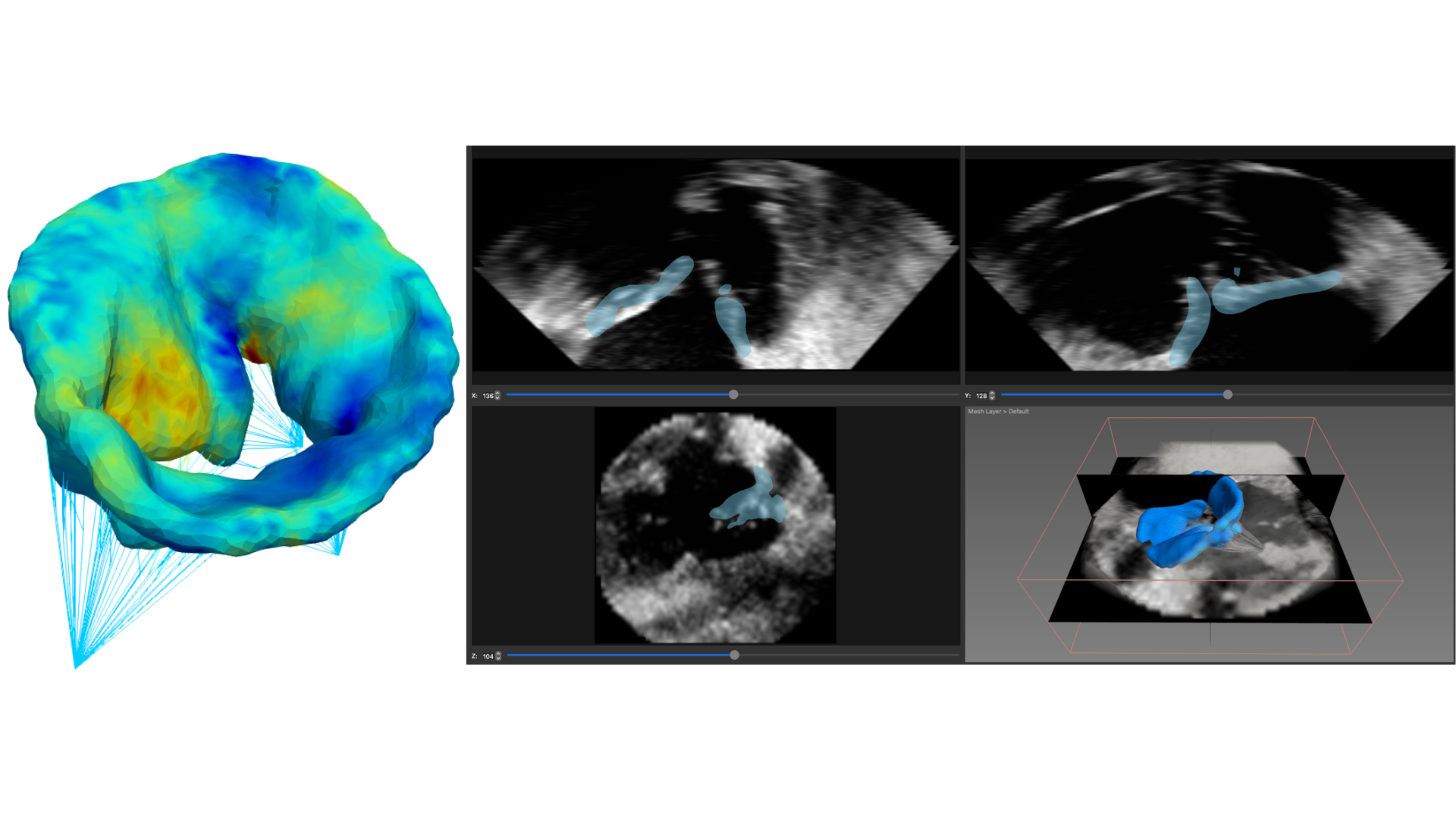
When Wensi Wu, Research Assistant Professor in Mechanical Engineering and Applied Mechanics (MEAM), first stepped into the world of computational modeling, she wasn’t thinking about hearts or hospitals. She was thinking about ships.
“I’ve always been fascinated by how powerful technologies can model what really happens in the world,” she says. “That curiosity led me to build models of everything from naval vessels to blast impacts on the brain.”
Today, Wu is a research faculty member at Penn Engineering, where she’s pivoted from ships to the circulatory system, developing “digital twins” of the human heart. Digital twins are virtual simulations made through computational modeling that provide a highly detailed virtual model of a physical system, object or process that mirrors its real-world counterpart in both structure and behavior. Unlike a simple simulation, a digital twin is continuously informed by real data, often from sensors, medical images or experimental results, which allows it to evolve and respond dynamically, just like the system it’s replicating. Wu’s work focuses on computational models that capture both the visible and invisible aspects of cardiac function: from fluid dynamics to the microstructure of heart tissue.
“Computational modeling allows you to see the invisible,” she explains. “Medical images can show you shapes in grayscale, but they can’t reveal the hidden forces, the tissue stiffness or the stress on a failing heart valve. With a digital twin, we can.”

From Ships to Surgery
Growing up with a deep interest in math and physics, Wu saw engineering as the most natural way to translate her skills into real-world impact. Initially guided by high school mentors into civil engineering, she explored a variety of research paths in college, from removing contaminants in water to simulating traumatic brain injuries.
Ultimately, it was the process of building models itself that captivated her.
“My love for the tool rather than the application is what has driven my scientific journey,” says Wu. “I want to know what’s happening mechanically, biologically, physiologically and what kind of tool could I build to learn those details?”
While pursuing her Ph.D. in computational mechanics, Wu studied ship structures in her advisor’s lab. But she never forgot a formative summer research project at Duke, where she built computational models of the brain to study traumatic head injuries. That early exposure to digital twins, digital representations of biological systems, stuck with her.
As her doctoral work came to a close, she reflected on her future. “I realized I wanted to do something that had more direct health relevance,” she says. “That’s when I found an opportunity to join a research group led by Dr. Matthew Jolley at the Children’s Hospital of Philadelphia (CHOP) that focused on congenital heart disease.”
That experience was transformative, not only for her research direction but for her mindset around what an engineer could get hired to do. Now at Penn, she’s using engineering tools to solve some of the heart’s most complex mysteries.
Building a Better Heart Model
In Wu’s lab, digital twins take shape as computational models of the heart that combine imaging data, mechanical properties and simulations of surgical interventions.
“We can model what happens during heart valve failure, or simulate surgical procedures like annuloplasty, where a ring is placed on a heart valve to help it close properly,” Wu explains. “Our models help us understand how that intervention affects fluid flow and tissue stress. If the size of the ring is too tight, it could cause damage in the opposite direction.”
Her models don’t just simulate any heart, they can be tailored to individual patients. Working with collaborators at Penn’s Perelman School of Medicine in the Department of Radiology and clinicians at CHOP, Wu combines general data to build foundational models and specific patient data to make predictions with clinical relevance.
“We want to identify patterns that differentiate a working valve from one prone to failure,” she says. “Our ultimate goal is to inform diagnosis, predict drug responses and guide surgical planning in a more personalized way.”
Collaborations and Mentoring at Penn
For Wu, Penn is the ideal place to bring this vision and interdisciplinary engineering to life.
“People come to Penn because of the collaborative environment,” she says. “Here, I’m constantly in dialogue with engineers, clinicians and mathematicians. It’s energizing.”
Her current research at Penn Engineering is focused on improving model fidelity and speed. She’s bridging biomechanical principles with machine learning algorithms to infer tissue properties directly from medical images. With help from mentors and clinicians, she’s working to develop next-generation cardiovascular models that provide immediate insights into stress, strain and tissue performance.
“I’m currently using ultrasound data and expanding collaborations across Penn Engineering, Penn Medicine and CHOP,” she says. “This multidisciplinary approach is crucial; engineers and clinicians need one another to make this kind of work impactful.”
In her recent paper, published in Acta Biomaterialia, she developed a noninvasive method that uses artificial intelligence and 3D heart ultrasound images to better understand the mechanical properties of heart valves in children. This approach greatly improved the accuracy of computer simulations used to plan valve repairs, potentially leading to more personalized and effective treatments.
Wu is not only passionate about research, she’s also very passionate about mentoring students.
“I know how powerful undergraduate research can be. I wouldn’t be here without it,” she says. “If I can help students discover how their engineering interests connect to real-world problems, whether that’s in medicine or infrastructure or environmental work, that would make me feel successful.”
Looking ahead, Wu hopes to pursue roles where she can expand her mentoring and research. But for now, she’s focused on building stronger models and stronger connections.
“I’m so happy to be working with clinicians who truly want to advance their work through collaboration,” she says. “At the end of the day, I want to help bridge that gap between engineering and medicine. And Penn is the perfect place to do that.”
Learn more about Wu’s work on her research website.
